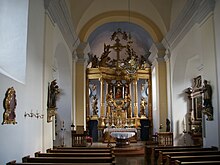Pilgrimage Church Mariahilf (Passau)
The pilgrimage church Mariahilf in Passau with the associated monastery rises on a hill above the Innstadt near the border with Austria .
Origin and Buildings

The pilgrimage was founded in 1622 by Domdekan Marquard von Schwendi (cf. Schwendi ) when he had a chapel built here with an image of the Virgin Mary, which the Passau artist Pius made in 1620 as a copy of the miraculous image of Mariahilf by Lucas Cranach the Elder . Schwendis Schlösschen is opposite the portal of the pilgrimage church. The pilgrimage church itself was built in 1624–1627 by Francesco Garbanino . The eye-catching spire helmets were not put on until 1665. The monastery and the St. Anna fountain adjoin the church. The covered pilgrimage staircase on the hill, laid out in 1628, comprises 321 steps. There is an early baroque crucifix at the entrance to the staircase.
The high altar from 1729 is characterized by the miraculous image. The side altars date from 1774 and show works by Joseph Bergler the Younger. The central nave carries the so-called Kaiserampel , a goldsmith's work by Lukas Lang from Augsburg. Emperor Leopold I donated it in 1676 on the occasion of his Passau wedding. The pilgrimage treasury is located in the sacristy. Capuchins took over the pilgrimage pastoral care.
Development of the pilgrimage
When Vienna was besieged by the Turks in 1683, Leopold I fled to Passau. In front of the miraculous image, the imperial couple prayed daily for rescue from the Turkish threat. When the Christian alliance then won the relief battle on the Kahlenberg under the battle motto “Maria hilf!” , The Passau Mariahilf image became the state image of grace of the Habsburg monarchy . The weapons captured by the defeated Turks in battle can be viewed in the confessional hall . The secularization brought in 1803, the resolution of the Capuchin monastery and the broad halt the pilgrimage. In 1809 Passau was occupied by Napoleonic troops. On the south-eastern slope of the hill you can still see the ramparts that Napoleon had built in 1809 to develop Passau into a fortress against Austria.
In the course of the restoration , more frequent pilgrimages were allowed again and a pilgrimage priests' convict was established in 1831. The Capuchins returned in 1890. The church is still an important place of pilgrimage today. In autumn 2002, Pauliner took over the pilgrimage church as the successor to the Capuchins. The first rector of the Mariahilf pilgrimage church was Fr. Mirko Legawiec OSPPE. From January 1st, 2010 to August 31st, 2014 Fr. Beniamin Bakowski OSPPE administered this office and on September 1st, 2014 Fr. Paul Binkowski OSPPE took over this position.
Web links
Coordinates: 48 ° 34 ′ 8.2 ″ N , 13 ° 28 ′ 11.5 ″ E

